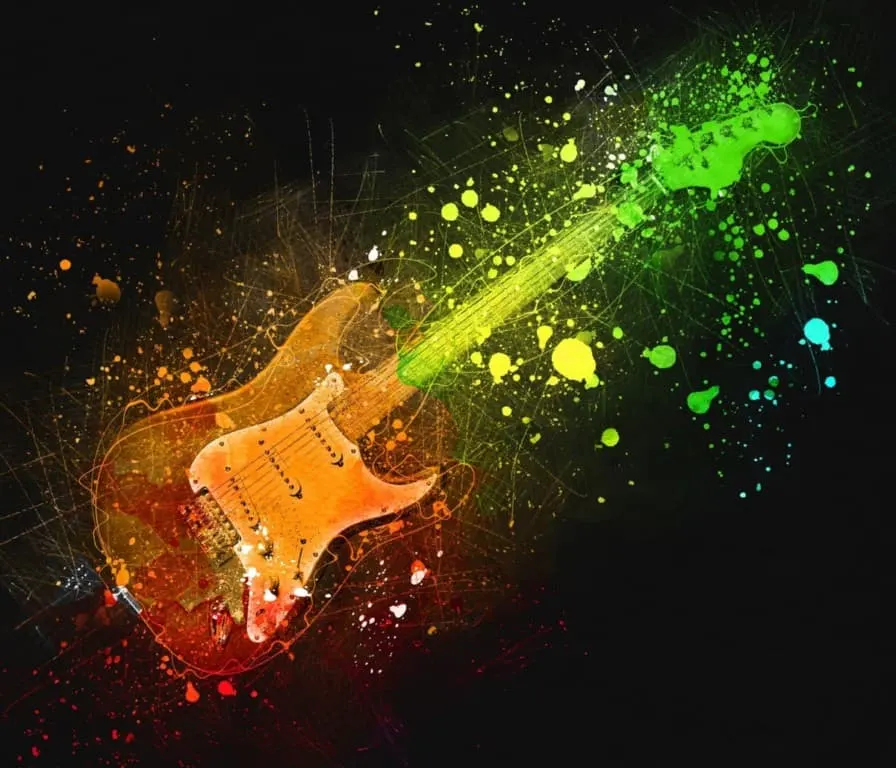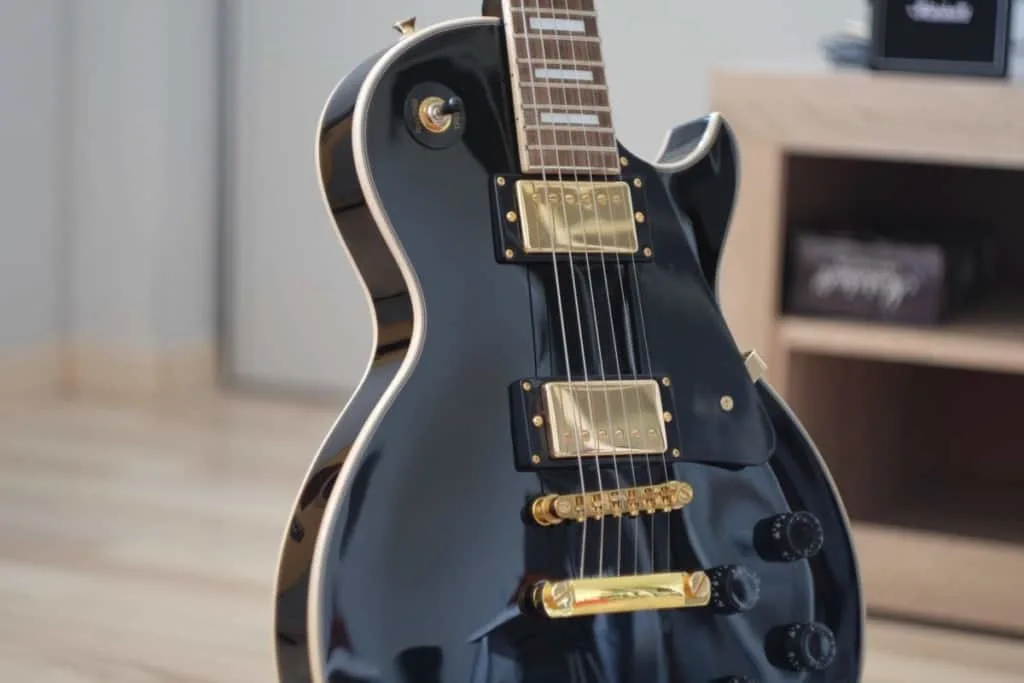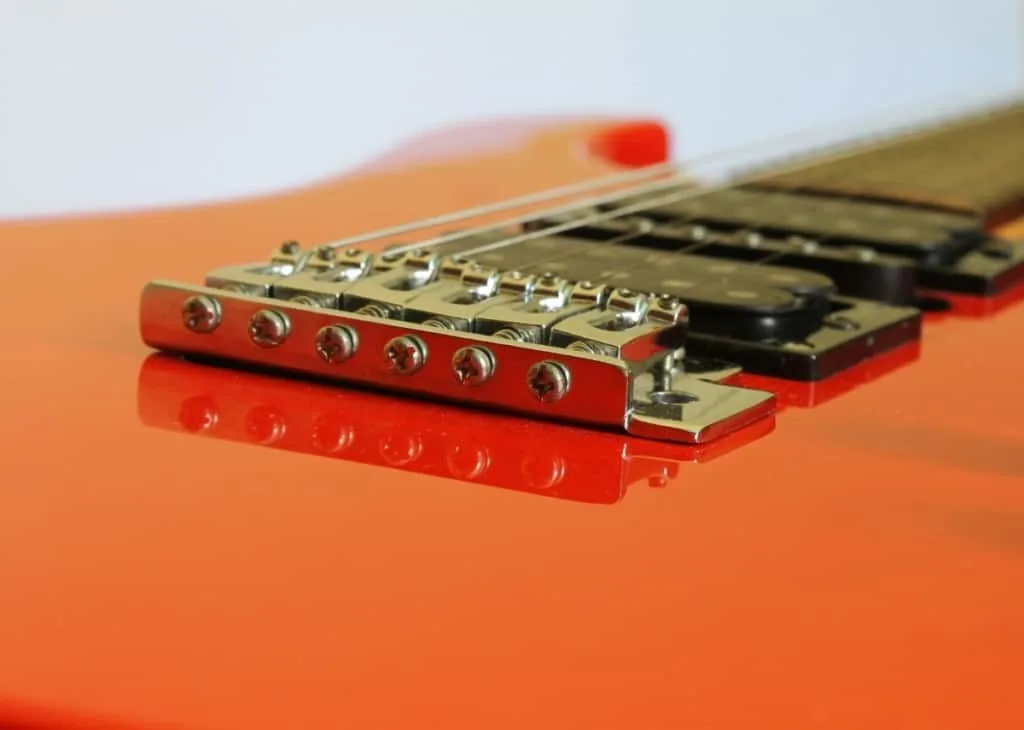As a touring musician, I’ve had to plug my guitar into a million different power amplifiers so I’m going to tell you exactly how to do it in each case scenario.
If you play electric guitar, you need somewhere to connect your guitar to amplify the volume. You have iconic guitar brands, iconic amp models, and a million options to choose from; but where and what else can you plug a guitar into?
So, can you plug a guitar into regular speakers?
The answer is very simple; yes, you can connect a guitar to regular speakers using various methods. The key is to plug your guitar in, not as if it was an instrument (there’s no dedicated input), but as if you were to plug in a sound source like a turntable or a CD player. Also, you can use several methods to plug a guitar into your computer and use the speakers attached to it for playing.
Take a look at my video from the Stampsound YouTube channel that accompanies this article.
Please consider subscribing to the channel here. It’s free after all!
Let’s get straight into it so you can start playing your guitar through those state-of-the-art speakers right now. Are you ready? Let’s make some noise!

Can You Play Guitar Through Your Stereo Speakers?
Now, what about stereo speakers? Let me tell you a little story, when I turned 13 (a long time ago!), my dad bought me this state-of-the-art Panasonic 3-cd stereo system that was a complete dream when it first came out.
Over time it stopped playing CDs and then it stopped playing cassettes as well. Nowadays it only plays the radio and my cellphone through the AUX input.
This is exactly what I want to talk to you about: the AUX input.
You can just purchase an adapter that goes from Dual RCA to a single 1/4” or 1/8” plug. If it is a 1/8” (generally used for playing your cellphone’s headphone output to the AUX) you need to get yourself a 1/8” to 1/4” adapter and go straight into your guitar’s input.
The one thing you need to bear in mind is that these speakers attached to the hi-fi stereo are very sensitive and fragile, so if you go too hot into them (plug your guitar to a distortion pedal and then to the AUX) you might blow them. Always keep it at a low volume.
When I updated my stereo system at home, I went from the Panasonic to a proper stereo receiver.
If you think about it, a stereo receiver is exactly that: an amplifier with multiple inputs. They are usually divided into two separate amps to create a true stereo sound.
So, what we can do in this case is, different from the AUX-in from our stereos, to create two signals. Your guitar is a mono instrument (like 99.9%) so you won’t be able to create a stereo sound unless you plug into a stereo pedal such as a delay (mono in, stereo out).
Take a look at this video to see what sort of sounds you can (still) achieve.
Can You Plug A Guitar Into A PA system?
This is the first case scenario that I can think of and it is the second-best place to plug your guitar in after a dedicated amplifier.
Back in the day, PA systems were not so different from guitar amps. They even had tubes because it was the only way to amplify the sound back then. Things have changed a lot, but the possibility to plug in your guitar straight to a PA is as close as ever.
In fact, if you ever heard anyone speak about modeling guitar amplifiers like the Kemper, Fractal, etc. those are all digital modules going straight into a mixer.
Let’s take a look at the options.
Direct Box
This is the first option most of us have used many times. A direct box transforms your plug, 1/4” TRS signal into an XLR balanced signal that then goes all the way into the mixer.
What is the benefit? Well, you don’t lose any signal on the way to the mixer and your guitar will sound ten times better.
You can and should use a direct box to go to the mixer whenever one is available.
What I’ve done many times is to use my pedals before going to the mixer to make my guitar sound better, warmer, more natural, and less sterile. It’s not the best solution, but that dreadful moment in which your guitar amp just dies on you, and you sadly find out you have no back-up for it and a show in about an hour can make this the only way out.
Actually, if it wasn’t for overdrives and distortions, the sound is not so bad for effects and cleanness.
Active Direct Box
The active direct box has a very small but meaningful difference with the passive direct boxes: it can reduce noise.
The noise in the guitar line when you are running pedals, single coils, and long cables, can be a problem. This is especially so when you are surrounded by high-consuming equipment like a PA system and lights.
Active direct boxes are either battery-operated or need a 9v AC adapter to work properly. If you are given the choice, always go for the active direct box instead of the passive version.
For a good example of an active Direct Box take a look at the popular ART Z on Amazon. You can view this here.
Modeling Amplifiers
Well, this is a great option and one that gigging guitar players use a lot. Again, the Achilles heel of modeling amps is distortions and overdrives. These can be emulated, but there is something about the harmonic overtones created by the tubes in high-end guitar amplifiers that just isn’t there.
That being said, if you are not a tone purist, you’ll probably never miss carrying around the extra load of a tube guitar amp or paying the fee for a rental.
The great thing about modeling amps (it can be a multi-effect unit) is that most of them come with a guitar cabinet emulator.
What does this mean? Well, it means that the sound after being processed will go through an emulator that will make it sound as if you were putting a microphone in front of a regular guitar amp (in most cases you can choose which). Check out the Fender MustangLT-50 Modeling Guitar Amplifier here on Amazon.
Some come in a standalone unit as a pedalboard and others come as a guitar amp head and a dedicated footswitch like the Kemper and such.
Modeling amps are a work in progress for many brands and an integrated solution for most of us. Whenever I´m doing live sessions and gigging some musical styles I’ll pack only my multi-effects processor and go straight to the mixer.
The big difference with regular amps, in case you are wondering, is that these could be thought of as digital preamps since there is no real power making the signal louder and hence, you can’t use it just with a speaker as you would use a regular guitar amp, you need a power amp section that is usually the PA of the place. You can also run them on headphones.
Take a look at this awesome video that discusses some of the best modeling amplifiers around today.
Can You Plug An Electric Guitar Straight Into The Mixer?
Speaking of going straight into the mixer, can this be done?
Well, if your mixer has a good preamp and power amp section, you can go straight into the mixer just as if you were playing a horizontal and very large Shure SM58 with strings. The problem, in this case, is that you need a long guitar cable.
On the other hand, your sound-sculpting capabilities will be very limited (the preamp from the mixer and the three-band EQ).
You might even be able to throw in some delay or reverb if the mixer has built-in effects. Out of all the ways you can connect your guitar to the mixer, this is the most limited one. Since you won’t be using a direct box, if the distance is long, you will get a degraded tone as well.
Take a look at my article here, where I picked 21 of my favorite guitar accessories.
RCA to TRS Connections For Electric Guitar
This is the kind of cable you need to buy. You’ll realize that you are only using the white or red RCA input; this is because it is a mono signal.
If you would like to transform it into a stereo signal (fake stereo, repeating the mono signal on both sides) you can get a Y-Adapter which goes from two mono inputs to a stereo output.
The disadvantages of a Y adapter is that you can’t plug a stereo TRS 1/4” to your guitar, because it only has a mono jack for it.
Will My Electric Guitar Be Mono Or Stereo Through Regular Speakers?
To solve the mono/stereo issue when you connect a guitar to regular speakers, you need to process your signal into a stereo path.
This is easily done; most pieces of gear will have this capability. The way I do it, in order to have two separate channels, is to plug in my trusty Boss DD-3 pedal. In one of the outputs, I put my distortion pedal and leave it on.
This way you can leave the “balance” knob in the middle and then have a mix between clean and dirty channels which is something you can’t do with a regular amplifier. You can achieve this with the delay pedal being off or on, it doesn’t make any difference.

Can You Plug An Electric Guitar Into A Home Theater Or Sound Bar
Anywhere that there is an AUX-in with RCA or 1/8” inputs, we can squeeze in a guitar cable and transform it.
Now, have I ever played my guitar with lush delays in stereo through a home theater? Yes, I have and I felt just like David Gilmour in Pompeii doing some crazy stuff. If you want to make the most out of this kind of system, you really need to go truly stereo.
Moreover, if your home theater or soundbar can generate a stereo sound, you will hear one of the repetitions of your delay on one side and the next on the other, which makes it almost a 3-d tone.
If you haven’t tried this before, with a home theatre or hi-fi equipment, I highly recommend you do. Even having an amp some feet away in my studio, I just do it sometimes to make it more fun.
How To Connect Your Guitar To Active Shelf Speakers
Active shelf speakers are becoming more and more common in many houses.
The idea of simply having them on the shelves with no power amp needed makes them a great choice. Some of them will have a simple RCA input you can go in through. With our handy RCA to 1/8” or 1/4” adapter, we can go straight in.
Now, if you have two bookshelf speakers that communicate among them, then it is very easy, you can go to a single one and use it as a speaker amp (just remember not to hit it with too much distortion too loud).
If they don’t, then what you’ll have to do is to get one of those Y-adapters or an A/B/Y box to use both at the same time with the mono signal of your guitar. Again, if you have a stereo delay, things are going crazy fun.
A great option for active shelf speakers are the Edifer R128OT, Check them out here.
Can You Connect An Electric Guitar Via Bluetooth?
Now, before we go into computers, let’s review the last kind of connection you can use for your guitar and a regular pair of speakers: Bluetooth. This technology can transmit a signal from a source to an amplifier.
The source of the signal is not relevant as long as you have Bluetooth capabilities on both ends. Now, how do we make our guitar Bluetooth friendly? This is my way of answering that:
· Bluetooth transmitter – There are a million brands out there, (This Getaria is excellent) they are sold to make anything transmit Bluetooth information and usually have a 1/8” on one end. This is what you can plug into your guitar using an adaptor. You can then transmit that signal to the receiver. The only catch here is that it will reach its destination with very low volume. Coming out of a pedalboard, multi-effects processor and such is always much better.
· Bluetooth Transmitter & Vox Amplug – Although you can use this with headphones, using the Vox amplug on your guitar and a Bluetooth transmitter coming out of the headphones jack will assure you the best results possible.
Check out the Vox AP2AC here on Amazon
Here’s an example of latency problems when using Bluetooth to connect an electric guitar.
How To Connect An Electric Guitar To Computer Speakers
Ok, you probably have a computer around. Most of us adult humans, usually own a computer.
It doesn’t need to be fancy or a MAC or anything like it, any computer would do. There are several ways to connect your instrument to the computer and let the audio come out of the speakers.
You can then even use the computer as a Bluetooth device and transmit the music to your speakers. So, let’s take a look at the different methods.
Going straight into sound in or microphone
Your computer, like most, already has an input with a dedicated DAC (Digital Audio Converter).
You can go straight to the microphone input of your laptop with a simple 1/8” to 1/4” adapter. This is not the best option, though, you might experience some latency and the volume and sound quality will be very annoying.
When there’s nothing else around, it can be a good substitute for the methods coming up next, but it should be your last option.
Here’s a great video showing you some options on how to do this.
TRS To USB Connections For Electric Guitars
There are some cables on the market that can transform your TRS 1/4” cable to a USB that goes straight to your computer and has a built-in DAC.
This way, you will simply plug the TRS to your guitar and the USB to the computer and the sound should come out of the speakers. It is not the best-quality DAC you can buy on the market but it is a much better-sounding solution than going straight to the microphone input with your guitar; so, this should be second to last.
If you have a guitar that simply won’t stay in tune check out my article on this here.
iRig
This invention works wonders to plug your guitar not only to your computer but also to your phone and use it as a Bluetooth source and reproduce the sound through a good pair of speakers. You can use it to drive many different types of software like Garage Band.
Take a look here at the various iRig products available.

Connecting Your Electric Guitar Via Audio Interface To A Computer
Speaking of software, the best way to use your guitar with your computer is an external audio interface without a shadow of a doubt. This interface will allow you to manipulate the sound of your instrument while being faithful to the original signal. In fact, plugging your guitar to an external audio interface you can access any DAW software and even make your records at home.
Let’s take a look at some of the things you need to turn your computer into a guitar wonderland.
· VST – This acronym stands for Virtual Studio Technology and it is very, very popular in the recording world today. What this means is that you can open a DAW like Pro Tools, Cubase Reaper, or whichever you like the most and use the guitar as a VST instrument through a plugin. This way you can not only play but record your guitar.
· Emulators – Emulators are programs that emulate the real guitar sound you would get from a number of different amps, pedals, and cabinets. These emulators can be from a number of brands; the ones I use the most and recommend is AmpliTube
The best thing about this software is that as long as you can plug your guitar to your computer, you can use them with or without a DAC.
Make sure you have a decent pair of monitors to hear your guitar sound through. Studio monitors and a good emulator are almost as good as the real deal.
Conclusion
Not all of these options are for the moment you don’t have an amp around, they can very well be lasting solutions.
For example, one of my dear friends who used to be a total metalhead lived in the tiniest apartment with his sister and had to give up playing loud, distorted guitar through an amp for the sake of harmony.
He bought an audio interface and used AmpliTube exclusively to plug his Schecter Jerry Horton (Papa Roach) signature with a dead roach in it and play out his favorite Slipknot tunes. Now, like many of my metal friends, turned full-on into electronic music.
I’ve even written an article on how to stop amps picking up radio frequencies, you can read it here.
There are many ways to plug a guitar to speakers without a conventional amplifier. You can actually use these tips as a momentary solution or you can opt for a virtual amplifier for good; that is up to you.
Happy (amp-free) Playing!
